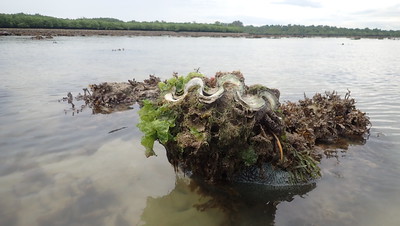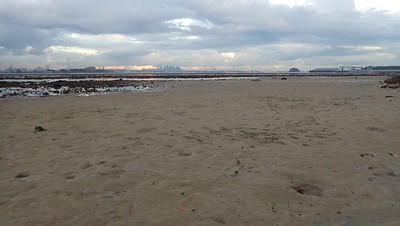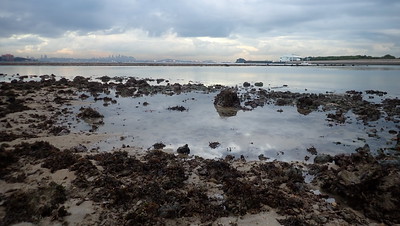We survey the rich reefs on Pulau Semakau (East) that lies next to the Landfill and opposite petrochemical plants on Pulau Bukom. The thunderstorm cleared soon after, for a magical muted sunrise.
It was a relief to see no mass coral bleaching. We also came across two Giant clams! I witnessed a struggle between snake and fish and the rest of the team saw rare snails and nudibranchs, and other interesting marine life.
This amazing reef lies right next to the landfill (the landfill seawall on the horizon in this photo).
Here's a better photo of the marine life next to the Landfill seawall by Kok Sheng.
These rich shores are also close to the petrochemical plants on Pulau Bukom.
It was great to see this Fluted giant clam. It was about 20cm long. It's probably different from the one I saw here in Jun 2020, which was about 30cm long.
Jianlin spotted another Fluted giant clam, it was a little smaller.
The 'Nat Geo' moment for me was to see this coiling snake swept along a shallow stream moving fast out of the mangroves. A closer look and I realised it was a Banded file snake trying to swallow a Black eel tailed catfish. The fish had its stiff (and sharp) pectoral and dorsal fins straight out. Which the snake just couldn't get past to swallow the fish. I could see the snake try different angles of approach, while holding onto the fish in its body coils. The snake at times seemed to grip with its tail to prevent itself from being swept along, but its struggles with the fish continued to dislodge the snake. I left after a while. When I went back to have another look, the fish was left gasping but alive, while the snake was nowhere to be seen. Wow!
Jianlin spotted TWO Tiger cowries! These snails are listed as 'Endangered' in the Red List of threatened animals of Singapore, which adds that although it is considered one of the most common coweries in the Indo-Pacific, and were found on Singapore's reefs in the past, it is now 'exceedingly rare'.
Kok Sheng spotted large squids on the reef edge.
Kok Sheng also captured this video of an anemonefish living happily in a sea anemone!
It was a relief to see no signs of mass coral bleaching. My last trip here was in Jun 2020 when we saw many signs of mass coral bleaching.
I saw healthy colonies of some coral that are seldom seen: large colonies of Lettuce corals, several small unmarked Carnation corals, one small Torch anchor coral, one small Acropora coral, several Cauliflower corals.
There were many healthy and large colonies of Brain corals, and also many commonly seen corals.
There were many large Leathery soft coral colonies on this shore. All those I saw were healthy.
There were also many healthy flowery soft corals, and I saw one Leathery sea fan.There is a narrow stretch of sandy shore near the landfill seawall.
The sand is alive! There were signs of Sand bubbler crabs and Acorn worms, and many Oval moon snails burrowing - most were small. There were several Haddon's carpet anemones and one Fire anemone that was retracted into the sand (probably due to the rain). There were also many egg strings that look like they were laid by Gong gong snails.
Looking like grandpa's dentures on the sand, there were many of these 'teeth' which turned out to be buried Strawberry cockles!
An area on the reef edge that is bare of corals and marine life is often likely to be caused by a boat striking the shore and destroying the corals there. There has never been much seagrass on this shore. I saw sprinkles of Spoon seagrass (tiny leaf blades) on the sandy high shore.
More about Pulau Semakau
Just as Changi Airport and Changi Beach are not the same even though they are near one another and share a name, Pulau Semakau is NOT the same as the Semakau Landfill. The Landfill was created by destroying all of Pulau Saking, and about half of the original Pulau Semakau by building a very long seawall. Fortunately, the landfill was constructed and is managed in such a way that the original mangroves, seagrass meadows and reefs on Pulau Semakau were allowed to remain. It is NOT true that the construction of the Landfill created the marine life found on Pulau Semakau. The marine life was there long before the Landfill was built.
What is the fate of this shore?
The 2013 landuse plan by the Ministry of National Development released in response to 2013 Population White Paper shows plans for 'possible future reclamation' (in light blue surrounded by dotted lines) that may impact the eastern shore of Pulau Semakau. More about the possible impact of the 2030 Landuse Plan on our shores.
Let's hope these shores will be spared this fate.
The Singapore Blue Plan 2018
Pulau Semakau and nearby islands and submerged reefs have been recommended by the Singapore Blue Plan 2018 for Immediate Conservation Priority.
The Blue Plan recommends the intertidal and subtidal marine areas of Pulau Semakau and adjacent Pulau Hantu, and Pulau Jong to be designated Marine Reserve.
The Blue Plan highlights that Pulau Semakau and its associated patch reefs comprise many ecosystems: coral reefs, mangrove areas, intertidal sandflats, seagrass meadows, and coral reefs. The subtidal area of Pulau Jong is larger than the terrestrial area. Pulau Hantu is a popular dive site has seen increasing interest in the past decade due to biodiversity awareness. If protection is accorded to these three islands, zonation plans for use can be implemented to manage tourism and human impacts.
DOWNLOAD the Plan, SUPPORT the Plan! More on the Singapore Blue Plan 2018 site.
Photos by others on this survey
Loh Kok Sheng
Jianlin Liu
Nathaniel Soon
Other shores surveyed
Marcus Ng was at Changi
Other shores surveyed
Vincent Choo surveyed Sentosa Serapong on 15 Dec
Vincent Choo also surveyed Bendera Bay on St John's Island on 13 Dec.

















